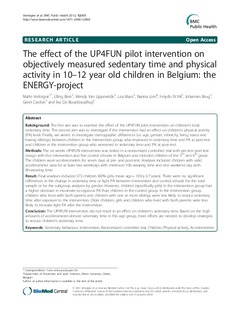The effect of the UP4FUN pilot intervention on objectively measured sedentary time and physical activity in 10-12 year old children in Belgium: the ENERGY-project
Verloigne, Maïte; Bere, Elling; van Lippevelde, Wendy; Maes, Lea; Lien, Nanna; Vik, Frøydis N.; Brug, Johannes; Cardon, Greet; De Bourdeaudhuij, Ilse
Journal article, Peer reviewed
Permanent lenke
http://hdl.handle.net/11250/139023Utgivelsesdato
2012Metadata
Vis full innførselSamlinger
Originalversjon
Verloigne, M., Bere, E., Van Lippevelde, W., Maes, L., Lien, N., Vik, F.N., . . . De Bourdeaudhuij, I. (2012). The effect of the UP4FUN pilot intervention on objectively measured sedentary time and physical activity in 10-12 year old children in Belgium: the ENERGY-project. Bmc Public Health, 12. doi: 10.1186/1471-2458-12-805 10.1186/1756-0500-5-434Sammendrag
Bakckground: The first aim was to examine the effect of the UP4FUN pilot intervention on children’s total
sedentary time. The second aim was to investigate if the intervention had an effect on children’s physical activity
(PA) level. Finally, we aimed to investigate demographic differences (i.e. age, gender, ethnicity, living status and
having siblings) between children in the intervention group who improved in sedentary time and PA at post-test
and children in the intervention group who worsened in sedentary time and PA at post-test.
Methods: The six weeks UP4FUN intervention was tested in a randomized controlled trial with pre-test post-test
design with five intervention and five control schools in Belgium and included children of the 5th and 6th grade.
The children wore accelerometers for seven days at pre- and post-test. Analyses included children with valid
accelerometer data for at least two weekdays with minimum 10h-wearing time and one weekend day with
8h-wearing time.
Result: Final analyses included 372 children (60% girls, mean age=10.9±0.7 years). There were no significant
differences in the change in sedentary time or light PA between intervention and control schools for the total
sample or for the subgroup analyses by gender. However, children (specifically girls) in the intervention group had
a higher decrease in moderate-to-vigorous PA than children in the control group. In the intervention group,
children who lived with both parents and children with one or more siblings were less likely to reduce sedentary
time after exposure to the intervention. Older children, girls and children who lived with both parents were less
likely to increase light PA after the intervention.
Conclusion: The UP4FUN intervention did not result in an effect on children’s sedentary time. Based on the high
amounts of accelerometer-derived sedentary time in this age group, more efforts are needed to develop strategies
to reduce children’s sedentary time.
Keywords: Sedentary behaviour, Intervention, Randomized controlled trial, Children, Physical activity, Accelerometer
Beskrivelse
Published version of an article in the journal: BMC Public Health. Also available from BMC: http://dx.doi.org/10.1186/1471-2458-12-805
